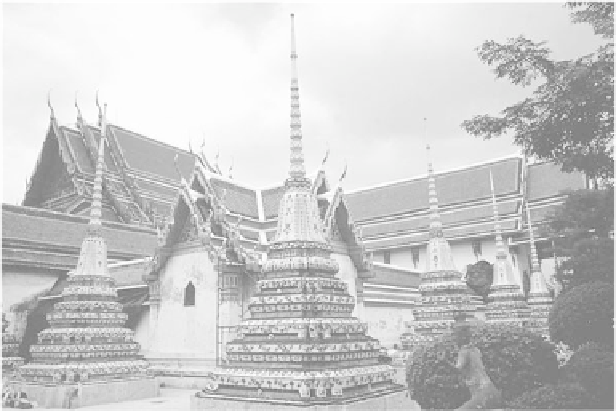Geography Reference
In-Depth Information
Figure 15-10
W at Pho, originating in the sixteenth century , is
the oldest and largest wat in Bangkok. It is also the
earliest center of public education.
Photograph
courtesy of B. A. Weightman.
competition in the newly established ASEAN Free
T Trade Area. Still, Thailand is the world's number two
sugar exporter after Brazil. Vietnamese rice exports, es-
pecially lower grades, are challenging thousands of
Thai subsistence farmers. Chicken and shrimp ex-
porters face competition from China. The rubber in-
dustry is threatened by cheaper labor in Indonesia.
Thailand is especially vulnerable to world market
prices as 70 percent of its land is planted in only six
commodities: rice, sugar, rubber, maize, cassava, and
sorghum.
Some changes are taking place. Improvements are
being made in mechanization and intensification, along
with land consolidation and better merchandising. A
dairy industry is taking off as cows from New Zealand
and the Netherlands are being crossbred with other
breeds to withstand Thailand' s climate. Agribusiness
firms are entering into new areas such as fresh and
processed fruit and cut flowers. The country has become
a center of tissue culture; laboratories commercially
mass-produce plant clones for customers around the
world. Further, Thai firms have been exporting agribusi-
ness technology to other developing countries (e.g.,
China, Indonesia, and Vietnam).
Export farming is practiced by large operators who
typically have mono-crop operations. Recently , the gov-
ernment has been promoting sustainable agriculture for
small farmers with 6 to 7 acres (2.5-3 ha) of land. These
farmers make up half of all farmers in the country . There
are four types of sustainable cropping being practiced in
various areas of Thailand.
Integrated production: Farmers raise at least two
crops in the same field. For example, paddy might
be combined with fish, or pigs with vegetables.
Farmers are being encouraged to select high-value
crops such as flowers and to maintain soil fertility
with animal, instead of chemical, fertilizer.
Organic farming: This is a system whereby only
organic fertilizer and herb-based pesticides are
used. This is designed to meet the increasing
demand for organic foods. Urban populations are
already buying such crops as organic rice and
vegetables.
Natural farming: With this methodology , there is no
tillage and no application of fertilizers, herbicides,
or insecticides. This is considered the ultimate form
of sustainable farming. A few natural farms are op-
erating in northern Thailand. The government is
conducting further research on the suitability of this
method in other regions.
Agro-forestry: This format involves combining agri-
culture with reforestation. For example, fruit trees,
coconut palms, and banana plants can be grown in
the same area and animals can forage underneath.
New TheoryFarming
New Theory Farming is a form of land and agricul-
tural management introduced by King Bhumiphol
Adulyadej in 1993. In the initial stage of this




















Search WWH ::

Custom Search